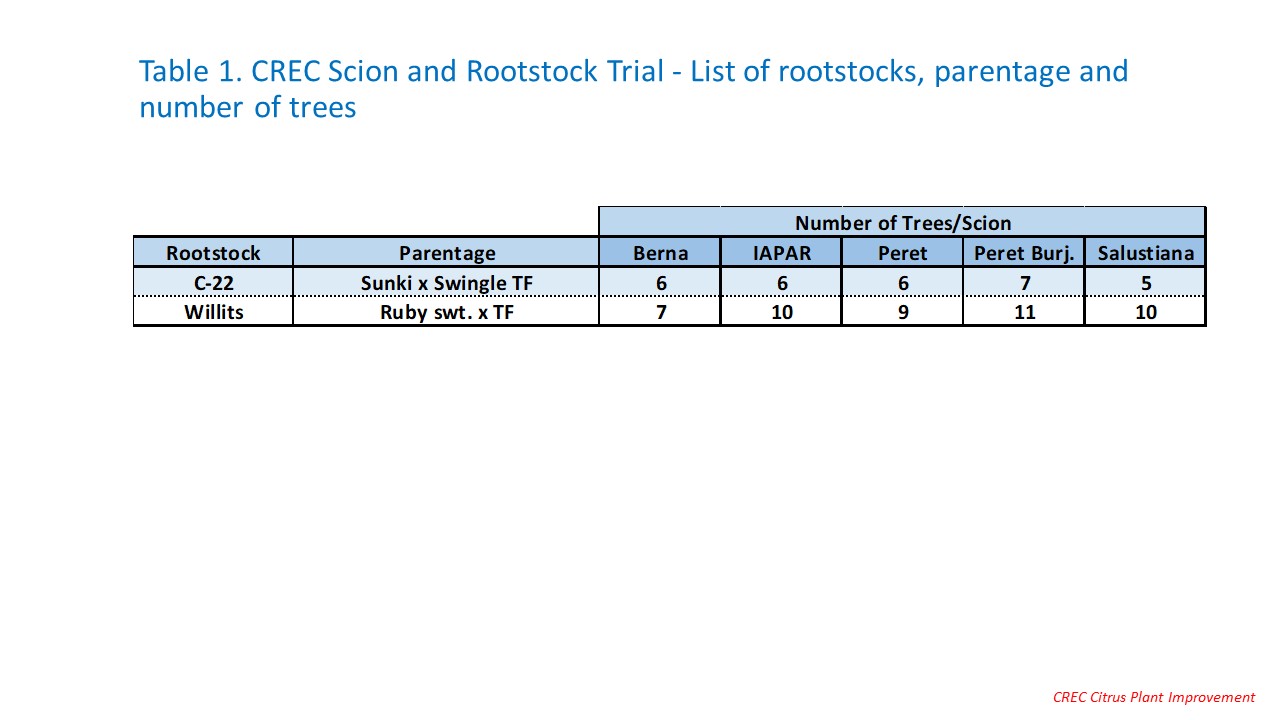CREC Scion Trial with Two Rootstocks, Lake Alfred
Dr. Bill Castle – Dr. Fred Gmitter – Dr. Jude Grosser
October 21, 2021 - updated
December 01, 2020 - updated
January 15, 2020 - posted
CREC Citrus Plant Improvement
CREC Scion and Rootstock Trial, Lake Alfred Description
After an international search, 5 exceptional sweet orange cultivars were selected for desired traits such as canker tolerance [IAPAR 73, an early-season cultivar from Brazil], high juice quality [Berna, Salustiana, Peret and Peret burjasot from Spain] and yield. Seeds were introduced and sown in March 2010 to produce trees for testing in Florida on two size-controlling rootstocks. After germination, seedlings were grown for about 1.5 years then used as the source of buds for producing the trial trees. Replicated sets of trees were planted in the Spring of 2013 including seedlings of each scion.
Teaching Block Scion and Rootstock Trial – Summary
- Location: CREC, Lake Alfred, Polk county.
- Scions: Berna, Salustiana, IAPAR, Peret, Peret burjasot
- Rootstocks: C-22 [Bitters] and Willits citrange
- Date planted: Spring 2013
- Design: Randomized complete-block; 1 – 3 replications
- Plot size: 2 – 5 trees
- Spacing: 10 x 20 ft. = 218 trees/acre
- Data:
- 2017-18: HLB rating; yield [boxes/tree]; fruit drop; juice quality
- 2018-19: Tree health and yield ratings
- 2018-19: Tree yield [pounds fruit/tree] for Berna & Salustiana
- 2018/19: PCR analysis re HLB
- 2019/20: Yield and HLB rating
- 2020/21: HLB rating and juice quality
- 2021/22: HLB rating
- Trial Status: ACTIVE
CREC Scion and Rootstock Trial - Interpretative summary [as of August 2021]:
- After 4 years in the field, the initial data and walk-through observations pointed to Salustiana and Berna as the most interesting scions among the five included in the trial.
- Salustiana and Berna were midseason in maturity based on Brix/acid ratio data which were not consistent enough to state that one cultivar was different from the other in that trait.
- Yield and HLB visible symptoms were similar.
- A PCR test showed that all trees were infected.
- Berna fruit juice generally was slightly better colored than Salustiana juice, but the fruit had a few seeds. Salustiana fruit were seedless.
- Among the fruit evaluated by the commercial processor, one Berna tree had high juice limonin and was excluded from further testing.
- Budwood of one tree each of Salustiana and Berna was submitted to FDACS-Division of Plant Industry, Citrus Budwood Registration Office for cleanup and entry into the parent tree program. Cleanup has been completed and buds are available.
- Rootstocks. The differences between C-22 and Willits were small and inconsistent with regard to tree height, HLB response, yield and juice quality.
- Conclusion. The evidence obtained thus far supports further evaluation of Salustiana and Berna as commercial varieties of midseason maturity in fresh and processing channels. The fresh-fruit use of these varieties was not directly studied, but Salustiana, in particular, has promise because of its seedlessness and exceptional juice flavor as determined from random sampling in the field.
- Caveat. The trial trees were produced using young seedling buds; thus, they are relatively juvenile, a factor that may be contributing so far to their mild HLB reaction.

.jpg)
